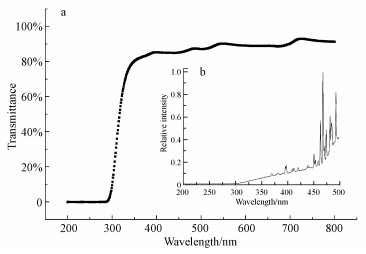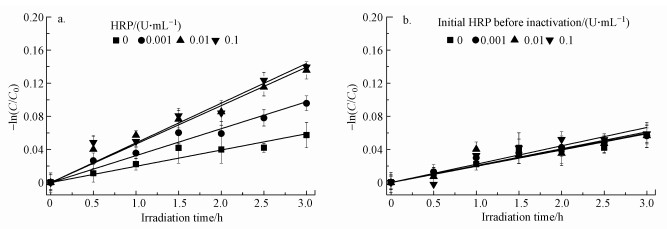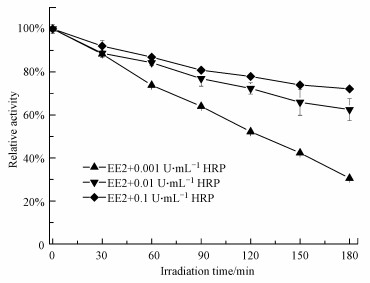2. 南京大学环境学院, 污染控制与资源化研究国家重点实验室, 南京 210023;
3. 南京理工大学环境与生物工程学院, 江苏省化学污染控制与资源化重点实验室, 南京 210094;
4. 河南师范大学环境学院, 黄淮水环境污染与防治教育部重点实验室, 河南省环境污染控制重点实验室, 新乡 453007
2. State Key Laboratory of Pollution Control and Resource Reuse, School of the Environment, Nanjing University, Nanjing 210023;
3. Jiangsu Key Laboratory of Chemical Pollution Control and Resources Reuse, School of Environmental and Biological Engineering, Nanjing University of Science and Technology, Nanjing 210094;
4. Henan Key Laboratory for Environmental Pollution Control, Key Laboratory for Yellow River and Huai River Water Environment and Pollution Control, Ministry of Education, School of Environment, Henan Normal University, Xinxiang 453007
内分泌干扰物(如雌激素)对人类和动植物具有潜在的慢性和急性毒性, 成为近年来的研究热点(Vos et al., 2000; 刘彬等, 2003; Mills et al., 2005; Zuo et al., 2013).由于污水处理厂的不完全去除和连续排放, 使得雌激素在天然水体中被广泛检出, 浓度水平为ng·L-1(Ying et al., 2002).由于雌激素在浓度很低(ng·L-1)的条件下仍具有较强的内分泌干扰效应, 因而成为地表水中的主要关注内分泌干扰物(Chowdhury et al., 2011).其中, 典型的4种雌激素为雌酮、17β-雌二醇(E2)、雌三醇和17α-乙炔雌二醇(EE2), 前三者为天然激素, 而EE2是避孕药的主要成分, 是人工合成的雌激素(Welshons et al., 2003; Mao et al., 2010; Caupos et al., 2011).
雌激素在水体的主要衰减过程有光降解和生物转化(Writer et al., 2012).光照是引起雌激素降解的主要因素(Yang et al., 2017), 如EE2在290~320 nm可直接吸收太阳光照射下而发生光降解(Grzybowski et al., 2014).生物降解和转化主要归因于能够降解这些化学物质的酶(Gurr et al., 2006), 其中, 过氧化物酶(POD)是自然环境中广泛存在的一种胞外酶(Senesi et al., 2009).POD的活性相当高, 比如在德国湖泊中活性可达到0.06~4.71 mmol·L-1·h-1(平均活性为1.39 mmol·L-1·h-1, 以2, 2′-连氮基-双-(3-乙基苯并二氢噻唑啉-6-磺酸)二铵盐(ABTS)为底物)(Buck et al., 2008); 在芬兰Mekkojärvi湖表层水中活性为73.6~272.9 nmol·L-1·h-1(平均活性为176.1 nmol·L-1·h-1, 以藜芦醇为底物)(Muenster et al., 1998).辣根过氧化物酶(HRP)、木质素过氧化物酶及大豆过氧化物酶等POD催化的氧化偶联反应是地表水中重要的生物转化过程之一, 可有效去除三氯生、乙酰氨基酚、多溴联苯醚等多种污染物(Lu et al., 2009; Feng et al., 2013; Li et al., 2017b).在水生环境中, 光降解和酶促转化通常同时发生, 且已有研究学者关注光降解和酶转化的复杂过程.如腐殖质光解产生的H2O2可激活POD从而促进雌激素的酶降解, 且腐殖质可生成活性氧物种促进雌激素的光降解(Li et al., 2017a), 但POD是否可直接影响雌激素的光转化目前尚不清楚.
基于此, 本文以HRP为POD的代表, 以EE2为目标污染物, 以1000 W氙灯模拟太阳光, 通过降解动力学、活性氧物种鉴定及曝气实验深入研究HRP对EE2光解的影响机制, 对光酶转化过程进行更深的了解, 以期为雌激素的环境归趋研究提供参考数据.
2 材料与方法(Materials and methods) 2.1 材料17α-乙炔基雌二醇(EE2, 纯度>99%)、辣根过氧化物酶(HRP, EC 1.11.1.7, 52 U·mg-1)和ABTS(纯度98%)购自美国Sigma-Aldrich有限公司; 甲醇(HPLC色谱纯)购自美国Tedia公司.实验所用水来自Milli-Q纯化系统的去离子水(18.25 MΩ).
2.2 HRP酶活测定方法1单位酶活为每分钟催化氧化1 μmol ABTS的酶量.用ABTS方法测定过氧化物酶HRP的酶活, 其原理是HRP在H2O2作用下能够将ABTS催化转化为阳离子自由基ABTS·+, 而ABTS·+在420 nm处有很强的特征吸收峰.具体操作为:在1 cm比色皿中, 加入2.3 mL 10 mmol·L-1磷酸盐缓冲液(PBS)、0.3 mL 2 mmol·L-1 H2O2和0.3 mL 2 mmol·L-1 ABTS, 最后加入0.1 mL HRP溶液, 启动反应. 迅速混合并将比色皿放置紫外分光光度计中, 每15 s记录一次在420 nm处的吸光度, 共记录3 min.酶活R(U·mL-1)= k(cm-1·min-1)×30/36(L·mmol-1·cm-1).
2.3 光降解实验光降解实验在XPA-7型光化学反应仪(南京胥江机电厂)中进行, 该反应仪配备低温恒温槽(常州博远实验分析仪器厂)使反应溶液的温度保持在(25.0±1.0) ℃.反应溶液体积为25 mL, 包含1.6 μmol·L-1的EE2溶液、不同酶活或失活的HRP(0.001、0.01、0.1 U·mL-1, 该酶活基于天然水体中POD浓度设定(Buck et al., 2008)), 反应体系为10 mmol·L-1磷酸缓冲溶液(PBS, pH=7.0), 反应管为50 mL带有石英塞的石英比色管, 并使其围绕光源旋转保证反应溶液受光均匀, 并以铝箔纸完全包裹的相同反应溶液为黑暗对照.光源为1000 W氙灯, 并配置滤光片截掉<290 nm波长范围的光, 发射光谱及滤光片的透过率见图 1.用紫外线辐照器(北京师范大学光电仪器厂)测得365 nm处的辐照强度为46.5 mW cm-2左右, 接近南京(32°20′N)夏季中午的光照强度.在预设反应间隔取样, 分别取2 mL和0.5 mL的反应溶液用于HRP和EE2的分析.在活性氧物种(ROS)鉴定试验中, 分别用100 mmol·L-1异丙醇(2-propanol)、10 μmol·L-1山梨酸(sorbic acid)、0.5 mmol·L-1硝基蓝四唑(NBT)和1.0 mmol·L-1呋喃甲醇(FFA)捕获·OH、三重态、O2·-和1O2(Shi et al., 2018; Xu et al., 2018; Zhou et al., 2018).
 |
| 图 1 滤光片的透过率(a)和过滤后的氙灯发射光谱(b) Fig. 1 The transmittance of the filter(a) and filtered xenon lamp emission spectrum (b) |
HRP失活方法:将HRP溶液在90 ℃水浴锅中保持60 min, 结束后用2.2节中HRP酶活测定方法测定不到HRP酶活.
溶解氧在EE2中的作用:反应溶液为1.6 μmol·L-1 EE2和0.01 U·mL-1 HRP, 分别曝氧气、氮气和不曝气, 定时取样监测EE2的浓度变化.
氙灯开关实验:将1.6 μmol·L-1 EE2溶液和1.6 μmol·L-1 EE2、0.01 U·mL-1 HRP溶液每照射1 h后关灯, 黑暗条件下放置1 h, 共计9 h, 测定反应溶液中EE2的浓度.
上述实验均设3个平行样, 标准偏差均在5%以内.
2.4 分析方法用配备有荧光检测器的安捷伦HPLC(1200系列, 美国)测定EE2浓度.检测波长:激发波长220 nm, 发射波长310 nm.流动相为80%的乙腈和20%的水, 流速为0.5 mL·min-1, 进样量30 μL.分离柱为安捷伦Eclipse XDB-C18柱(250 mm × 4 mm, 5 μm)(安捷伦, 美国).
3 结果与讨论(Results and discussion) 3.1 HRP存在下的17α-乙炔基雌二醇光解根据天然水体中的胞外过氧化物酶活性范围, 本课题组研究了0.001~0.1 U·mL-1 HRP对EE2光降解的影响, 结果如图 2所示.各种条件下EE2的光解均符合假一级动力学, 随着辐射时间的增加, EE2的降解率也增加.EE2直接光解速率常数为0.0238 h-1, 大于Ren等(2017)文献中报道的EE2直接光解速率常数(0.0068 h-1), 这是因为他们使用的光源为500 W氙灯, 光强弱于本实验中选择的1000 W氙灯.EE2如此低的速率常数说明其直接光解很慢, 这是由于其在290~320 nm波长范围内的光吸收比较微弱.
 |
| 图 2 不同酶活(a)和失活的HRP(b)存在下EE2的光降解动力学 Fig. 2 Degradation kinetics of EE2 in the presence of active HRP with varying activity (a) and inactive (b) |
加入HRP后, EE2的光降解被显著促进, 且促进程度随着酶活的增加而增加.但当酶活高于0.01 U·mL-1时促进效果不再显著增加, 即0.1 U·mL-1和0.01 U·mL-1 HRP对EE2的促进程度差不多, 说明HRP促进EE2光解的最佳酶活为0.01 U·mL-1, 此时光解速率常数为0.1024 h-1, 约为直接光解速率常数的4倍多.将相对应酶活的HRP失活, 研究失活的HRP对EE2光解的影响, 结果发现, 失活的HRP对EE2的光解几乎没有影响.这些结果说明只有有活性的HRP才能和光协同促进EE2的光解.
3.2 反应过程中酶活的变化本研究同时测定了反应体系中HRP活性随时间的变化(图 3).由图可知, HRP的活性随着光照时间的增加逐渐下降, 对于不同初始酶活来讲, 活性越高, 失活越慢.光照3 h后, 初始酶活为0.001、0.01和0.1 U·mL-1的HRP分别降低了70%、35%和20%, 表明EE2在环境水体中较长时间内都能被降解.
 |
| 图 3 不同酶活的HRP和EE2反应体系中HRP酶活随光照时间的变化 Fig. 3 The activity of HRP in the reaction systems containing different active HRP and EE2 as a function of irradiation time |
HRP中含有氨基酸, 如色氨酸(Trp)、组氨酸(His)和酪氨酸(Tyr)等, 这些氨基酸能够吸收光从而发生直接光解(Boreen et al., 2008).且有文献报道溶解性有机质中的类蛋白部分也可发生光解, 且光照后荧光强度变弱(Mostofa et al., 2007; Winter et al., 2007).因此, HRP作为一种酶蛋白, 可能会与EE2竞争光而抑制其直接光解.因此, 要扣除HRP的光屏蔽作用.通过式(1)~(2)计算不同活性下的光屏蔽因子Sλ.

|
(1) |

|
(2) |
式中, Sλ为屏蔽因子, A为特定波长下的衰减系数(cm-1), b为光反应中所用比色管的路径长度(2 cm).根据计算结果(表 1), 在考察的酶活范围内HRP的Sλ值接近于1, 没有发现HRP的光屏蔽作用, 这可能是因为使用的HRP浓度较低或对光的吸收较弱.这些结果表明HRP只促进了EE2的光降解, 没有光屏蔽作用.
| 表 1 不同酶活下HRP的光屏蔽因子 Table 1 The light screening factor of HRP with different enzyme activity |
通过开关灯实验进一步探索光照在雌激素光解中的作用.如图 4所示, 在氙灯光照1 h期间, HRP介导下EE2的光降解速率比仅有EE2存在下的光降解速率快, 关闭氙灯, 在黑暗条件下放置1 h, EE2的浓度基本保持不变.继续打开氙灯1 h, HRP介导下EE2的光降解速率又被加快, 光解速率接近第一次光照阶段.这一结果表明光照是导致HRP促进EE2光解的不可或缺的条件, 且关灯后EE2的浓度基本保持不变, 说明光照下EE2和HRP体系中产生了寿命很短的物质参与了HRP介导的EE2光降解.
 |
| 图 4 HRP存在下光的影响作用 Fig. 4 The effect of light in the presence of HRP |
有学者认为光照条件下量子点CdS QDs产生的活性氧物种(ROS)如·OH和O2·-自由基可激活细胞色素P450单加氧酶(Ipe et al., 2006); 然后, Fruk等(2007)证明了这种量子点可以激活以亚铁血红素为活性中心的多种过氧化物酶, 包括HRP、肌红蛋白和细胞色素C过氧化物酶.因此, 通过自由基猝灭实验推测EE2体系中产生的主要活性氧物种, 结果如图 5所示.在·OH猝灭剂异丙醇(2-propanol, 100 mmol·L-1)存在下, EE2的光降解动力学曲线与直接光解接近, 表明·OH对EE2光降解的贡献微不足道, 这与雌激素在溶解性黑碳介导的光转化中, ·OH的作用微不足道是一致的(Zhou et al., 2018).在O2·-捕获剂NBT和1O2猝灭剂FFA存在的情况下, 与对照相比, EE2的光解被极大地抑制, 假一级动力学速率常数分别降低了约62.5%和67.4%, 表明O2·-和1O2对EE2的光解起着不可或缺的作用.加入3EE2*捕获剂山梨酸后, EE2的光解被抑制了约37.2%, 表明3EE2*也参与了EE2的光解.除此之外, 通过过氧化物酶-莨菪亭荧光衰减法测到了EE2体系中H2O2的浓度(Holm et al., 1987), 且H2O2的生成符合零级动力学, 生成速率为42 nmol·L-1·h-1(图 5b), 上述结果说明EE2可以发生自敏化, 之前通过实验和理论计算验证雌二醇可在直接光解中通过产生ROS发生自敏化(Wang et al., 2020).根据相关文献(Zhang et al., 2010; Zhang et al., 2012; Ji et al., 2013)推测EE2自敏化生成ROS的过程见式(3)~(9).

|
(3) |

|
(4) |

|
(5) |

|
(6) |

|
(7) |

|
(8) |

|
(9) |
 |
| 图 5 EE2直接光解中生成的活性氧物种验证实验 Fig. 5 The validation experiment of ROS generated by EE2 direct photolysis |
EE2在光照条件下可以被激发形成单重态, 接着单线态1EE2*可通过系间穿越(ISC)过程形成三线态3EE2*, 然后3EE2*分别通过能量传递和电子转移形成1O2和O2·-, O2·-会与溶液中的H+结合生成H2O2.因此, 可以推测EE2自敏化产生的ROS激活了HRP, 使基态HRP被氧化为一个含有铁氧键的四价铁和卟啉π阳离子自由基的中间体(称之为化合物Ⅰ);随后底物EE2被抽取一个电子给化合物Ⅰ, 使化合物Ⅰ被还原为另一个酶中间体(称之为化合物Ⅱ), 而底物EE2本身生成了一个苯氧自由基;而化合物Ⅱ从另一个底物EE2抽取一个电子使其回到了基态, 而EE2生成了第2个苯氧自由基.两个苯氧自由基通过重排、偶联等非酶反应形成高分子聚合物及其他化合物(Mao et al., 2010).通过曝氧曝氮实验进一步验证了活性氧的作用, 结果如图 6所示.EE2和HRP的溶液经过30 min曝氧气后光照, 与对照相比, 该反应体系下EE2的光解速率明显加快19.2%, 同时, EE2的光解作用随着溶液中溶解氧的消除而被抑制了44.7%, 说明活性氧对激活HRP而促进EE2降解影响重大.氧气是单线态/三线态物质的猝灭剂(Ji et al., 2013),
 |
| 图 6 HRP存在下溶解氧的影响 Fig. 6 The effect of dissolved oxygen in the presence of HRP |
消除氧气可以增加3EE2*的寿命, 从而可以使很大一部分3EE2*转化(Ryan et al., 2011).但是, 由于缺少氧气, 形成较少的ROS可能会抑制自敏光解作用及酶降解.溶解氧的存在对于ROS的形成至关重要(反应式(4)、(5)和(8)), ROS既可以促进EE2的自敏化降解又可以激活HRP促进酶降解.因此, 由ROS引起的降解在EE2的光酶协同降解中起着重要作用.
另外, 有学者认为·OH也能激发酶活(Ipe et al., 2006; Fruk et al., 2007).·OH、1O2、O2·-和H2O2在天然水体中普遍存在, 浓度分别为10-14~10-19、10-12~10-14、10-9~10-11和10-9~10-7 mol·L-1(周磊, 2014), 与污染物并存, 因此, 过氧化物酶会影响污染物的环境归趋.
与此同时, 需要注意的是, 文中EE2浓度(μg·L-1)远远高于其环境浓度(ng·L-1);文中虽以1000 W氙灯模拟太阳光, 以实际水体中POD浓度范围设定文中所用HRP酶活范围, 但光照强度和酶活种类与实际水体仍有一定的差异;由于天然水体复杂, 水质成分(如腐殖质、金属离子、硝酸根离子等)可能会影响光酶协同降解EE2, 这可能导致本文的研究结果具有一定的局限性.因此, HRP和光对环境浓度下EE2的协同影响机制有待进一步研究, 且在后续研究中, 应逐渐将反应体系复杂化.
4 结论(Conclusions)1) HRP的存在能够显著促进EE2的光降解, 且促进作用随酶活的增大先增大后趋于平缓, 最佳酶活为0.1 U·mL-1, 但失活的HRP不能促进EE2的光降解.
2) HRP在光照射较长时间内均可保持较高的活性, 且酶活越高, 失活越慢, 从而可以持续地促进EE2的光酶协同降解.
3) EE2可在光照条件下发生直接光解和敏化光解, 且自敏化产生的活性物种可激活HRP, 从而促进了EE2在光照条件下的酶降解.
4) 在光酶体系中分别曝氧气和氮气, EE2降解速率分别被加快和抑制, 进一步验证了活性氧物种在光酶协同降解EE2中的重要性.
Boreen A L, Edhlund B L, Cotner J B, et al. 2008. Indirect photodegradation of dissolved free amino acids: The contribution of singlet oxygen and the differential reactivity of DOM from various sources[J]. Environmental Science & Technology, 42: 5492-5498. |
Buck U, Babenzien H D, Zwirnmann E. 2008. Extracellular peroxidase activity in an experimentally divided lake (Grosse Fuchskuhle, northern Germany)[J]. Aquatic Microbial Ecology, 51: 97-103. DOI:10.3354/ame01188 |
Caupos E, Mazellier P, Croue J P. 2011. Photodegradation of estrone enhanced by dissolved organic matter under simulated sunlight[J]. Water Research, 45: 3341-3350. DOI:10.1016/j.watres.2011.03.047 |
Chowdhury R R, Charpentier P A, Ray M B. 2011. Photodegradation of 17β-estradiol in aquatic solution under solar irradiation: Kinetics and influencing water parameters[J]. Journal of Photochemistry and Photobiology A: Chemistry, 219: 67-75. DOI:10.1016/j.jphotochem.2011.01.019 |
Feng Y P, Mao L, Chen Y J, et al. 2013. Ligninase-mediated transformation of 4, 4'-dibromodiphenyl ether (BDE 15)[J]. Environmental Science and Pollution Research, 20: 6667-6675. DOI:10.1007/s11356-013-1847-y |
Fruk L, Rajendran V, Spengler M, et al. 2007. Light-induced triggering of peroxidase activity using quantum dots[J]. Chembiochem: a European Journal of Chemical Biology, 8: 2195-2198. DOI:10.1002/cbic.200700594 |
Grzybowski W, Szydłowski J. 2014. The impact of chromophoric dissolved organic matter on the photodegradation of 17α-ethinylestradiol (EE2) in natural waters[J]. Chemosphere, 111: 13-17. DOI:10.1016/j.chemosphere.2014.03.062 |
Gurr C J, Reinhard M. 2006. Harnessing Natural Attenuation of Pharmaceuticals and Hormones in Rivers[J]. Environmental Science & Technology, 40: 2872-2876. |
Holm T R, George G K, Barcelona M J. 1987. Fluorometric-determination of hydrogen-peroxide in groundwater[J]. Analytical Chemistry, 59: 582-586. DOI:10.1021/ac00131a010 |
Ipe B I, Niemeyer C M. 2006. Nanohybride aus quantenpunkten und cytochrom P450 als photokatalysatoren[J]. Angewandte Chemie, 118: 519-522. DOI:10.1002/ange.200503084 |
Ji Y F, Zhou L, Zhang Y, et al. 2013. Photochemical degradation of sunscreen agent 2-phenylbenzimidazole-5-sulfonic acid in different water matrices[J]. Water Research, 47: 5865-5875. DOI:10.1016/j.watres.2013.07.009 |
刘彬, 刘先利, 吴峰, 等. 2003. 水溶液中17α-乙炔基雌二醇的光降解[J]. 环境科学学报, 23(4): 508-511. DOI:10.3321/j.issn:0253-2468.2003.04.019 |
Li J H, Zhang Y, Huang Q G, et al. 2017. Degradation of organic pollutants mediated by extracellular peroxidase in simulated sunlit humic waters: A case study with 17beta-estradiol[J]. Journal of Hazardous Materials, 331: 123-131. DOI:10.1016/j.jhazmat.2017.02.033 |
Li J H, Zhang Y, Peng J B, et al. 2017. The effect of dissolved organic matter on soybean peroxidase-mediated removal of triclosan in water[J]. Chemosphere, 172: 399-407. DOI:10.1016/j.chemosphere.2017.01.013 |
Lu J H, Huang Q G, Mao L. 2009. Removal of acetaminophen using enzyme-mediated oxidative coupling processes: I.Reaction rates and pathways[J]. Environmental Science & Technology, 43: 7062-7067. |
Mao L, Huang Q G, Luo Q, et al. 2010. Ligninase-mediated removal of 17β-estradiol from water in the presence of natural organic matter: Efficiency and pathways[J]. Chemosphere, 80: 469-473. DOI:10.1016/j.chemosphere.2010.03.054 |
Mills L J, Chichester C. 2005. Review of evidence: Are endocrine-disrupting chemicals in the aquatic environment impacting fish populations?[J]. Science of the Total Environment, 343: 1-34. DOI:10.1016/j.scitotenv.2004.12.070 |
Mostofa K, Yoshioka T, Konohira E, et al. 2007. Dynamics and characteristics of fluorescent dissolved organic matter in the groundwater, river and lake water[J]. Water, Air, and Soil Pollution, 184: 157-176. DOI:10.1007/s11270-007-9405-1 |
Muenster U, Heikkinen E, Salonen K, et al. 1998. Tracing of peroxidase activity in humic lake water[J]. Acta Hydrochimica et Hydrobiologica, 26: 158-166. DOI:10.1002/(SICI)1521-401X(199805)26:3<158::AID-AHEH158>3.0.CO;2-Q |
Ren D, Huang B, Xiong D, et al. 2017. Photodegradation of 17alpha-ethynylestradiol in dissolved humic substances solution: Kinetics, mechanism and estrogenicity variation[J]. Journal of Environmental Sciences (China), 54: 196-205. DOI:10.1016/j.jes.2016.03.002 |
Ryan C C, Tan D T, Arnold W A. 2011. Direct and indirect photolysis of sulfamethoxazole and trimethoprim in wastewater treatment plant effluent[J]. Water Research, 45: 1280-1286. DOI:10.1016/j.watres.2010.10.005 |
Senesi N, Xing B, Huang P M. 2009. Biophysico-Chemical Processes Involving Natural Nonliving Organic Matter in Environmental Systems//Formation Mechanisms of Humic Substances in the Environment[M]. A John Wiley & Sons, Inc. (USA), 41-109
|
Shi H H, Wang G W, Huang Q G, et al. 2018. The mutual promotion of photolysis and laccase-catalysis on removal of dichlorophen from water under simulated sunlight irradiation[J]. Chemical Engineering Journal, 338: 392-400. DOI:10.1016/j.cej.2018.01.026 |
Vos J G, Dybing E, Greim H A, et al. 2000. Health effects of endocrine-disrupting chemicals on wildlife, with special reference to the European situation[J]. Critical Reviews Toxicology, 30: 71-133. DOI:10.1080/10408440091159176 |
Wang M J, Shi Q R, Shi H H, et al. 2020. The promotion effect of phenolic acid compound on the photo-removal of estrogen from water under simulated sunlight irradiation[J]. Chemical Engineering Journal, 387: 123999. DOI:10.1016/j.cej.2019.123999 |
Welshons W V, Thayer K A, Judy B M, et al. 2003. Large effects from small exposures.I.Mechanisms for endocrine-disrupting chemicals with estrogenic activity[J]. Environmental Health Perspectives, 111: 994-1006. DOI:10.1289/ehp.5494 |
Winter A R, Fish T A E, Playle R C, et al. 2007. Photodegradation of natural organic matter from diverse freshwater sources[J]. Aquatic Toxicology, 84: 215-222. DOI:10.1016/j.aquatox.2007.04.014 |
Writer J H, Ryan J N, Keefe S H, et al. 2012. Fate of 4-nonylphenol and 17β-estradiol in the Redwood River of Minnesota[J]. Environmental Science & Technology, 46: 860-868. |
Xu L P, Li H, Mitch W A, et al. 2018. Enhanced phototransformation of tetracycline at smectite clay surfaces under simulated sunlight via a lewis-base catalyzed alkalization mechanism[J]. Environmental Science & Technology, 53: 710-718. |
Yang Y, Li J H, Lu K, et al. 2017. Transformation of 17alpha-ethinylestradiol by simultaneous photo-enzymatic process in Humic water[J]. Chemosphere, 178: 432-438. DOI:10.1016/j.chemosphere.2017.03.077 |
Ying G G, Kookana R S, Ru Y J. 2002. Occurrence and fate of hormone steroids in the environment[J]. Environment International, 28: 545-551. DOI:10.1016/S0160-4120(02)00075-2 |
Zhang S Y, Chen J W, Qiao X L, et al. 2010. Quantum chemical investigation and experimental verification on the aquatic photochemistry of the sunscreen 2-phenylbenzimidazole-5-sulfonic acid[J]. Environmental Science & Technology, 44: 7484-7490. |
周磊. 2014. 天然水体中防晒剂对氨基苯甲酸和碳纳米管的光化学行为研究[D]. 南京: 南京大学
|
Zhang Y, Del Vecchio R, Blough N V. 2012. Investigating the mechanism of hydrogen peroxide photoproduction by humic substances[J]. Environmental Science & Technology, 46: 11836-11843. |
Zhou Z C, Chen B N, Qu X L, et al. 2018. Dissolved black carbon as an efficient sensitizer in the photochemical transformation of 17beta-Estradiol in aqueous solution[J]. Environmental Science & Technology, 52: 10391-10399. |
Zuo Y G, Zhang K, Zhou S. 2013. Determination of estrogenic steroids and microbial and photochemical degradation of 17 alpha-ethinylestradiol (EE2) in lake surface water, a case study[J]. Environmental Science-Processes & Impacts, 15: 1529-1535. |
 2021, Vol. 41
2021, Vol. 41


